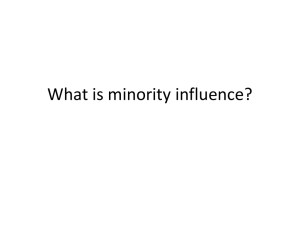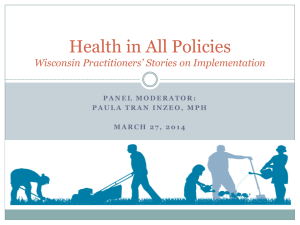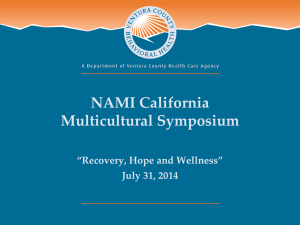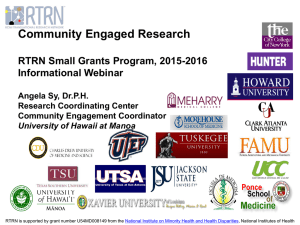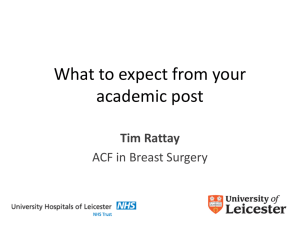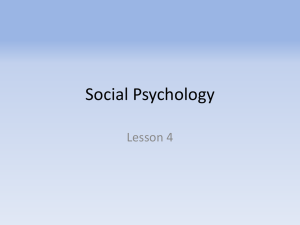to webinar on health disparities
advertisement
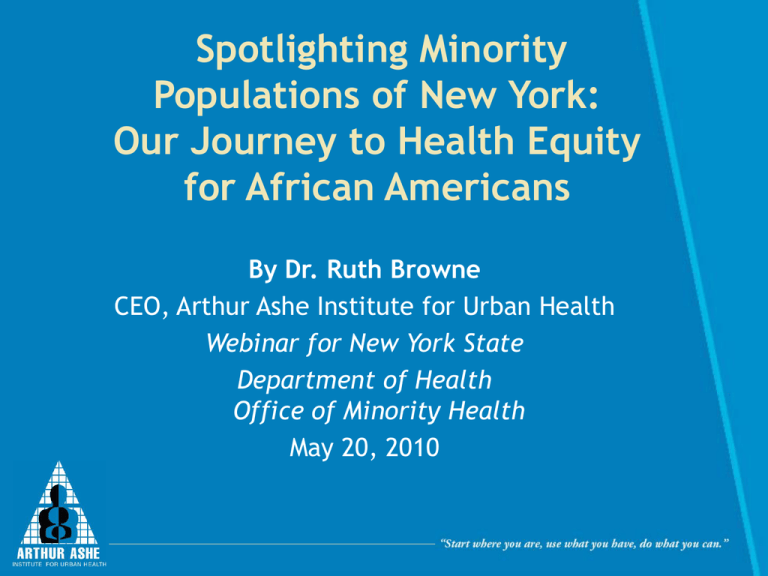
Spotlighting Minority Populations of New York: Our Journey to Health Equity for African Americans By Dr. Ruth Browne CEO, Arthur Ashe Institute for Urban Health Webinar for New York State Department of Health Office of Minority Health May 20, 2010 The Arthur Ashe Institute for Urban Health Is located in multi-ethnic Brooklyn at SUNY Downstate, and collaborates with a diverse array of partners to design, incubate and replicate neighborhood-based interventions based on a Community Health Empowerment Model addressing health conditions disproportionately affecting minorities. Health Disparities: Conditions Disproportionately Affecting African Americans Entrenched Problem, Complex Causation Health disparities result from the complex interaction among factors such as biology, the environment, and specific behaviors significantly impacted by a shortage of racial and ethnic minority health professionals, discrimination, and inequities in income, education, and access to health care. Healthy People 2010 Goals Still Unmet for African Americans The US Department of Health’s Initiative Healthy People 2010 was designed to achieve two overarching goals: Increase Quality and Years of Healthy Life Eliminate Health Disparities African Americans Experience Disparities in All Leading Health Indicators Physical Activity Overweight and Obesity Tobacco Use Substance Abuse Responsible Sexual Behavior Mental Health Injury and Violence Environmental Quality Immunization Access to Health Care In New York City 30 percent more African American men and 20 percent more African American women die of all causes than their white counterparts Infant mortality is highest among African American babies and African Americans have the highest rate of new HIV diagnoses One in four African American and Latino New Yorkers are obese, increasing their risk of disease, disability and premature death Every year, this disparity in mortality accounts for more than 4000 deaths. Nationally African Americans’ expected lifespan is seven years shorter than their white peers’ African Americans are twice as likely to die from heart disease, diabetes and various forms of cancer African Americans are half as likely as whites to be insured, significantly decreasing usage of preventative care, timely screening, early detection, and quality treatment options. Under-representation in Healthcare Workforce Although service utilization and health outcomes improve when healthcare practitioners are culturally similar to their patients African Americans represent only two percent of the healthcare workforce, despite representing over a quarter of the general population. Critical National Need for Successful Models of Change The Census Bureau predicts racial and ethnic minority populations in the U.S. will double in size during the 21st century. Innovative strategic partnerships among all segments of our society including the community will be critical in the NIH effort to eliminate health disparities. The Institute’s Approach: Leverage Community Assets All communities have assets that can be engaged on behalf of the communities health Assets include businesses, churches, local health and social service agencies, personal care establishments, libraries, schools, etc. Proprietors, personal care givers, stylists, barbers, ministers/faith leaders, nurses and other health care practitioners who live in communities can be engaged in community health empowerment (CHE) as lay health advocates Identify Local Heroes: Lay Health Advocates facilitate behavioral change and engage communities in academic /community partnerships. They 1. 2. 3. 4. 5. 6. 7. Participate in the design, implementation and evaluation of interventions Build trust by drawing on existing relationships and standing in community Provide informal counseling and health education based on most current research Tailor content for cultural and linguistic fit Assess readiness and individualize message to stages of change Offer connection to health services through referral and follow-up services Build individual and community capacity for advocacy and dissemination of tailored health messages. Community Health Empowerment Model Underlies programs addressing ethnic, racial, and gender disparities, targeting diseases that affect our communities disproportionately Addresses the whole individual to inform health decisionmaking through trusted venues and messengers Builds knowledge and skill for individuals to address their own health concerns Develops advocacy skills for communities to build health equity Facilitates increasing representation of minorities in the health professions CHE Model Underlies Multi-Pronged Program Design We partner with a wide variety of grassroots, institutional organizations and policy makers to provide Community Health Interventions Outreach initiatives using lay health advocates in trusted venues, such as barber shops, salons and Laundromats Health Science Academy Culturally appropriate after-school programming to increase the number of minority healthcare practitioners Brooklyn Disparities Center Research, training and advocacy through a 13 year old campus-community partnership with SUNY Downstate Medical Center. The CHE Model in Action: Three Institute Programs Soul Sense of Beauty (Community Health Intervention) Health Science Academy (After School Science Enrichment) Brooklyn Health Disparities Center (Research, Outreach, Training and Advocacy) Soul Sense of Beauty: Behavioral Health Change Model The Salon as Community Health Center: Meeting People Where They Are In minority communities, the beauty salon is a traditional safehaven and cultural epicenter where social norms and public opinions about health are often shaped Hair stylists and cosmetologists already discuss a wide range of health topics with their clients, especially in the areas of dieting and physical activity Beauty professionals in minority communities enjoy a level of trust from their clients that opens up avenues for communication that may not always be available to researchers from outside the community. Soul Sense of Beauty: Overview Innovative breast cancer awareness program National Cancer Institute funded training program for hairstylists to teach them how to talk to their own customers about breast health Three messages: practice self-examination, get annual clinical breast exam, mammography Objectives To select and train community-based professional stylists in specific knowledge, attitudes, and practices of delivering breast cancer control messages to their customers To examine, via a randomized controlled trial, the impact of stylist-delivered breast cancer control messages on the breast health behaviors of beauty salon customers Objectives (continued) To develop a portable stylist training and communications package for ongoing training To conduct an outcome evaluation of breast health behaviors of salon customers comparing method of stylist training (video versus live-training) To organize a community-based Health and Beauty Council to continue the stylist training program in support of the intervention Cultural Targeting Focus groups were conducted with African American and Afro-Caribbean stylists to Inform the cultural content of the training prior to its development Determine the cultural acceptance of the training curriculum and breast health messages Activities Customers were pretested on knowledge at each salon Breast health information, including videos and shower cards on breast self-exams and pamphlets on breast health were available at each salon Church volunteers - trained to assist in demonstrating breast self-exams during the Health and Beauty Days Breast Cancer Survivor – played vital role in recruitment, promotion of breast healthy behaviors Results & Highlights 2,284 pre intervention surveys were collected from salon customers Stylists from 50 salons in Brooklyn completed the program Self-reported exposure to stylistdelivered messages was associated with improved breast self-examination rates and with greater intentions to have a clinical breast examination Results & Highlights (continued) 8 church facilitators trained Media coverage: New York Times, BET, NY 1, ABC local TV and German TV Mammography provided by ACS and American Italian Cancer Foundation Stylists were recognized by the Brooklyn Borough President at a special ceremony Lasting relationships to build on for next intervention Refining and Adapting the Model • The behavioral health change model developed through Soul Sense of Beauty provides an adaptable base for the Institute’s future work. • Content based on current research is being developed for interventions related to colorectal cancer, HIV, cardio-vascular disease, prostate cancer etc. • Our approach is continually refined based on an evaluation of health behavior of customers based on stylist delivered health messages in a trusted environment. Health Science Academy: Increasing Minority Representation in the Healthcare Workforce Health Science Academy: Overview Free after school science enrichment A three-year college level curriculum in Anatomy and Physiology High school and middle school minority students are exposed to a broad spectrum of health science careers Objectives To prepare minority high school students to be competitive in applying to, entering and completing higher education in the health sciences To develop, through interactive activities, habits of mind and methods of questioning to succeed in rigorous academic study To provide experience in community service, an understanding of health disparities and a commitment to improving healthcare in their communities Activities We partner with 12 local schools with high concentration of minority and immigrant students We recruit students with an overall 85% average who are interested in science and willing to commit to a three-year program We offer a rigorous highly interactive curriculum of Anatomy and Physiology at SUNY Downstate, Brooklyn’s only Academic Medical Center We support faculty made up of graduate students and other clinicians, targeting minority practitioners who can serve as role models and mentors Activities (continued) We supplement the curriculum with trips, community service, internships, dissections, lab tours and guest speakers We frame the clinical content within a context of health disparities, drawing from community experience, supplemented with course work providing strategies for academic success We extend the health education pipeline to younger students through piloting a career exposure program “Be the Cure” in two Brooklyn middle schools. Results and Highlights Nearly 75% of students’ parents and 26% of the students were born outside the US Since 1994, more than 750 young people have attended the academy, with over 250 graduating and going onto to college Approximately 60% of students in the last two graduating classes have majored in science. Results and Highlights The Academy enrolls between 150 and 186 students annually for the last three years Over 86% of the 2009 class indicated interest in health science careers This summer 30 Academy students will study health disparities and research methods and perform internships in local community-based organizations under an NIH P20 grant. The Brooklyn Health Disparities Center: Local Infrastructure for National Impact Overview: Community Outreach & Information Dissemination (COID) Core Partnering with SUNY Downstate and the Brooklyn Borough President’s Office, the Institute leads the Brooklyn Health Disparities Center Because of its location and cultivating student and faculty bodies that reflect the communities it serves, Center partners have gained a tremendous wealth of expertise on minority health and health disparities. Funded by NIH, the Center is anchored through points of connection in grassroots organizations engaged in direct services to neighborhood residents. . Community Advisory Board American Cancer Society Arab-American Family Support Center Brooklyn Perinatal Network Caribbean Women’s Health Association Diaspora Community Services Flatbush Haitian Center Greater Southern Brooklyn Health Coalition Haitian Centers Council Korean Community Services (KCS) Public Health Program Make the Road By Walking Goal of COID The goal of the COID is to translate scientific information on reducing risks of cardiovascular disease and to deliver this information to the Brooklyn community utilizing already-established mechanisms of outreach that engage community service providers. Objectives Our overarching long term goal is to reduce morbidity and mortality by . Improving health knowledge Informing decision-making Facilitating behavior change Expanding access to care Increasing minority representation in the healthcare workforce Activities Coordinate advocacy efforts with community partners and academic medical center Prepare clinicians to offer more culturally competent care and community based partners to build capacity Organize a coalition to build a more responsive and effective health education pipeline to increase minority representation in the healthcare workforce Engage in Community Based Participatory Research to address root causes of health disparities, publish and widely disseminate findings. Critical Elements of Community Empowerment: Recommendations Summary The three programs, guided by our model, address complex root causes through approaches and activities designed to narrow gaps in Trust Information Motivation Access Representation Closing the Trust Gap Reliable culturally-tailored health messages are delivered by community advocates in comfortable informal settings. Closing the Information Gap Accurate current information on wellness, prevention, screening is distributed through trusted community venues by well-supported peer educators to inform health decision-making. Closing the Motivation Gap Community advocates are coached to meet people at individual stages of readiness, build on incremental behavioral change to encourage positive “social contagion,” passing accurate health messages along through family and neighborhood networks. Closing the Access Gap Information on screening is accompanied with referrals to culturally competent clinicians and means to enroll in low or no cost health coverage. Closing Representation Gap Local minority youth explore and prepare for health careers, engage in disparities solutions, and serve as information resources for their community and policy makers through the Health Science Academy, located at Downstate, facilitating increasing minority representation in the healthcare workforce. Concluding Recommendations • • • • Convene a representative advisory board Elicit their input and insights in the design of the intervention, crafting of health messages, implementation and evaluation Leave expertise in the community by educating and supporting lay advocates to carry the message, evaluate the results and adapt the intervention Interpret findings for both sides of the Campus/Community partnership and disseminate strategically for optimum impact.

